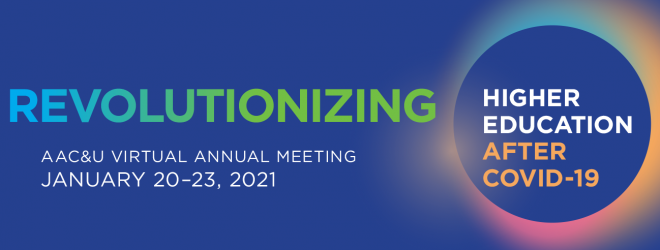LSC Session at the 2021 AAC&U Annual Meeting
Presenters:
- Pamela E. Scott-Johnson, Dean, College of Natural and Social Sciences—California State University Los Angeles
- Robert A. Kolvoord, Dean, College of Integrated Science and Engineering (CISE) — James Madison University
- Susan R. Singer, Vice President for Academic Affairs and Provost — Rollins College
The pandemic has changed more than our current use of space. It has stimulated a conversation about a radical evolution in our conception of learning spaces. The LSC session at the 2021 AAC&U Annual Conference was an opportunity for faculty and administrators from institutions of all types to explore questions that campuses are asking and should be asking as they shape and reshape environments in which learners experience learning. 2020 has been a challenging year for thinking about repurposing spaces, about how attention to space matters now and into the future, about how spaces serve broader institutional goals in the service of equity and inclusivity. This discussion was shaped around questions that have emerged from conversations among academics and architects involved with the LSC during 2020.
Our common need is to identify questions to be asked in order that a foundation for planning evolves as campuses respond to the COVID-19 challenge. In Spring 2020, a small, representative group within the LSC began convening to identify and explore such questions. The goal was to begin to gather interesting questions being asked, “aha” ideas in how spaces are being repurposed, reimagined for the 2020 – 2021 academic year, and gain an emerging sense from the community about what next.
Some early questions:
- How can the historic sense of an agora be captured in virtual learning spaces?
- How can we take advantage of existing institutional assets as we begin to respond to the COV19 challenge?
- Might this challenge be also an opportunity to focus as a community on issues such as equity and inclusion?
- How can we use attention to spaces that facilitate learning while giving attention to the safety and well-being of all in our community?
- What does blended learning mean in this context for students?
- If we claim that learning can happen anytime and anywhere, what does that mean?
- How can we ensure that the time taken to wrestle with the COV19 challenge results in a common awareness that attention to space matters—and how it matters for our particular community?
- Can the historic sense of an agora be captured in virtual learning spaces? and can this challenge be also an opportunity to focus as a community on issues such as equity and inclusion?
This LSC session at AAC&U was an opportunity to engage a broader and more diverse community in sharing and discussing questions being asked and “aha” examples emerging around physical and virtual spaces, then translating that discussion into a planning prospectus for future attention to spaces for learning in a world challenged by COV19.

